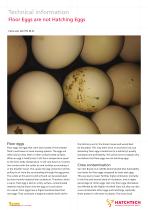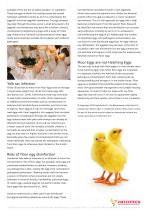
Catalog excerpts

Technical information Floor Eggs are not Hatching Eggs Carla van der Pol M.Sc. Floor eggs the hatchery and in the broiler house and would best Floor eggs are eggs that were laid outside of the breeder be discarded. This may seem to be an economic loss, but flock’s next boxes in loose housing systems. The eggs are d iscarding floor eggs is beneficial to a hatchery’s quality often laid on dirty litter or other contaminated surfaces. standards and profitability. This article aims to explain why When an egg is freshly laid, it still has a temperature equal we believe that floor eggs are not hatching eggs. to the hen’s body temperature. It will cool down as it comes into contact with the cooler air and surfaces surrounding it Cross contamination in the breeder house. This causes the egg contents to shrink, Van den Brand et al. (2016) demonstrated that hatchability pulling in air from the surroundings through the egg pores. was lower for floor eggs compared to clean nest eggs. The cuticle at this point is still soft and can be penetrated This was due to lower fertility, higher embryonic mortality by more harmful material than outside air. Therefore, when in the first and second week of incubation, and a higher a warm, fresh egg is laid on a dirty surface, contaminated p ercentage of rotten eggs. Not only floor eggs themselves m aterial may be drawn into the egg as it cools down. are affected by the higher microbial load, but they can also As a result, floor eggs have a higher bacterial load than cross contaminate other eggs and hatchlings, especially nest eggs. They constitute a hygiene problem both ithin w those present in the same incubator. The
Open the catalog to page 1
example of this are the so called ‘bangers’ or ‘exploders’. wet disinfection procedures result in wet eggshells, These are eggs in which the rotting process has caused which may create the optimal micro climate for bacterial hydrogen sulphide to build up, but it is contained by the growth when the eggs are placed in a warm incubation eggshell and inner eggshell membranes. The egg contents e nvironment. This is a risk especially for eggs with a high may leak through the pores and at a small provocation, the bacterial contamination from the parent flock. Research eggshell and membranes...
Open the catalog to page 2All HatchTech B.V. catalogs and technical brochures
-
HatchTech 88 Hatcher Basket
2 Pages
-
HatchTech Fumigation Room
2 Pages
-
HatchTech 88 Setter Trolley
2 Pages
-
HatchTech 88 Setter Tray
2 Pages
-
HatchTech Chick Storage Room
2 Pages
-
HatchBrood Brooding Control
4 Pages
-
HT TECH ABS Heat production
3 Pages
-
HT TECH Light-dark
2 Pages
-
HatchTech Microclimer
8 Pages

















